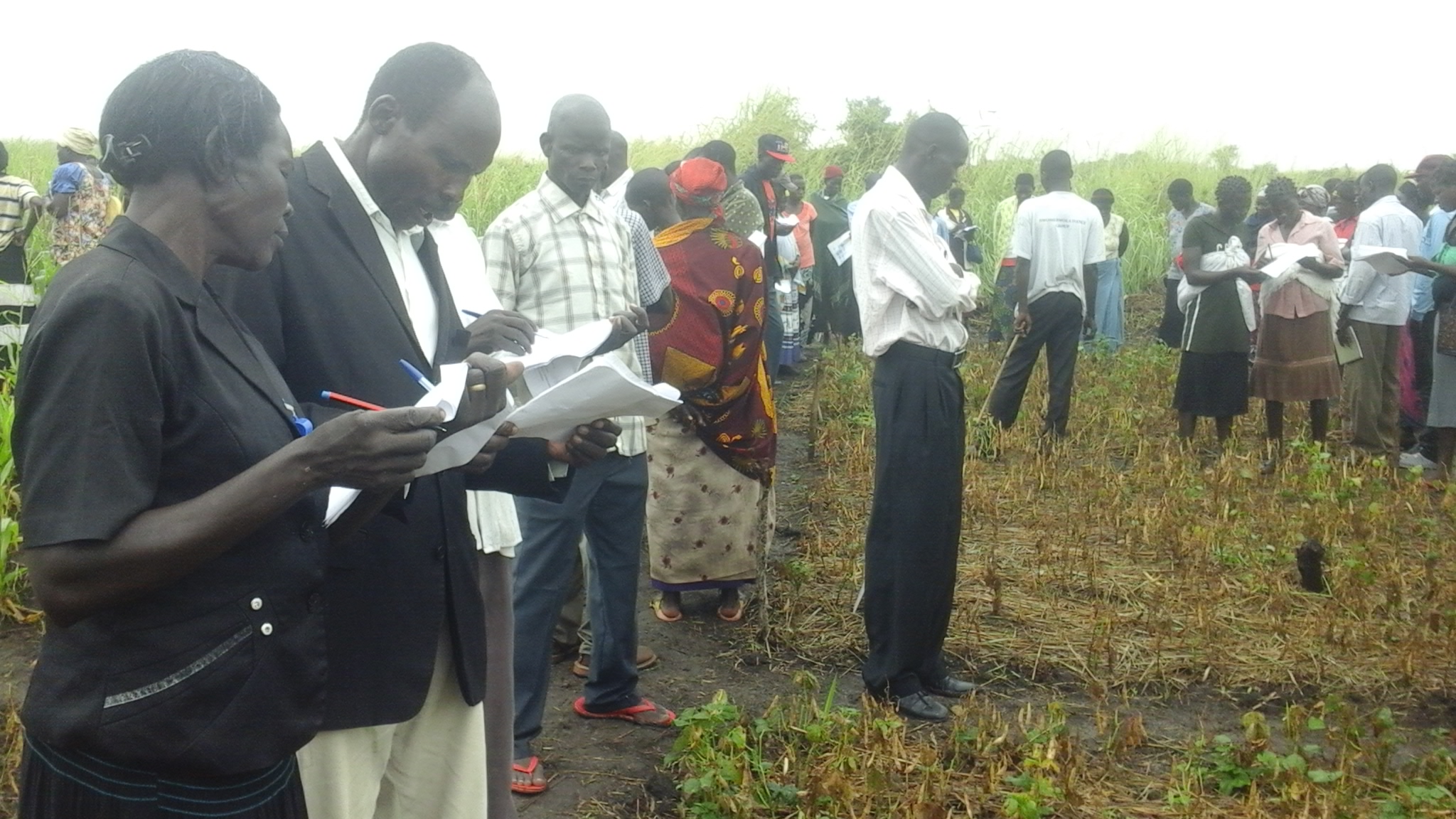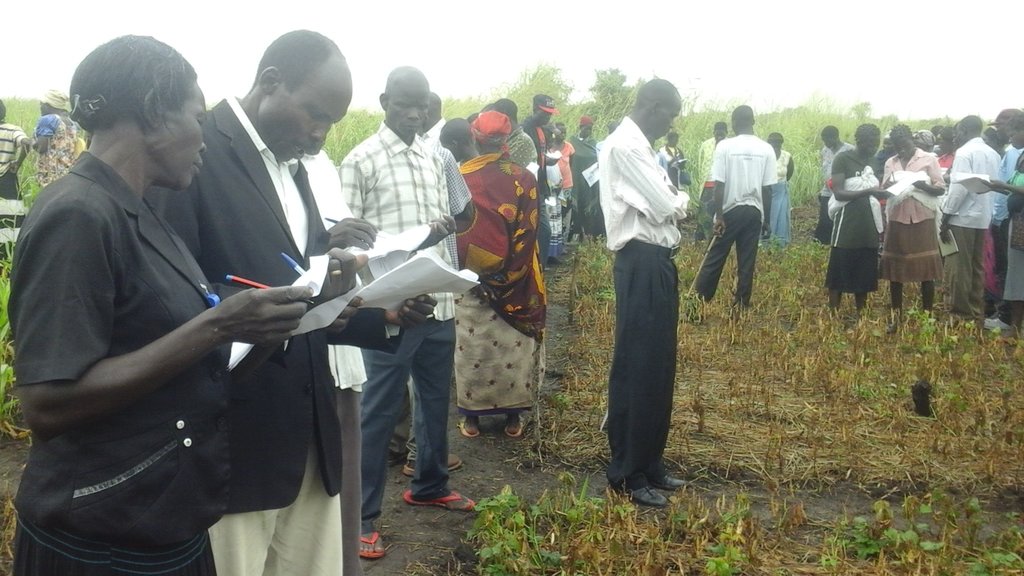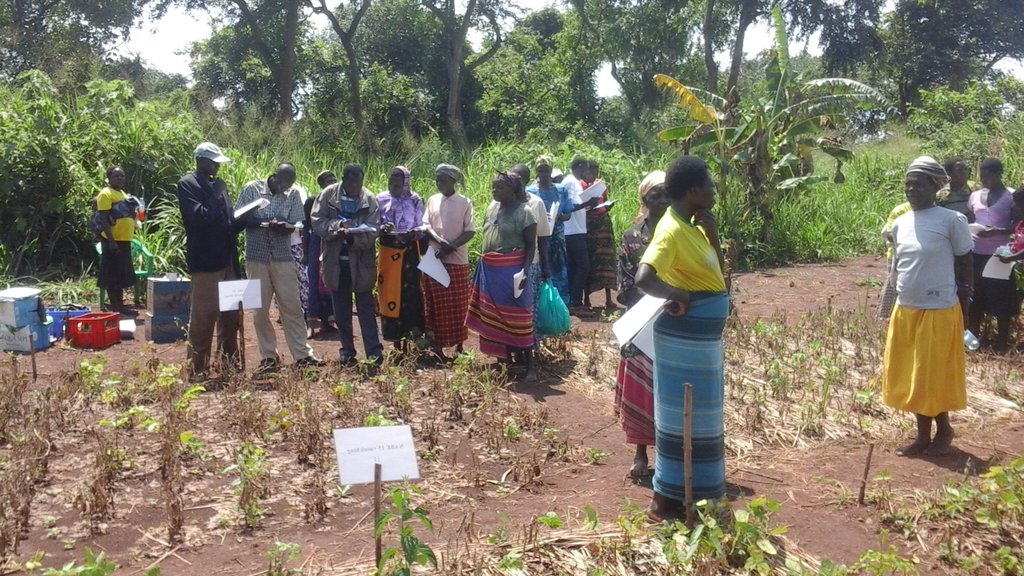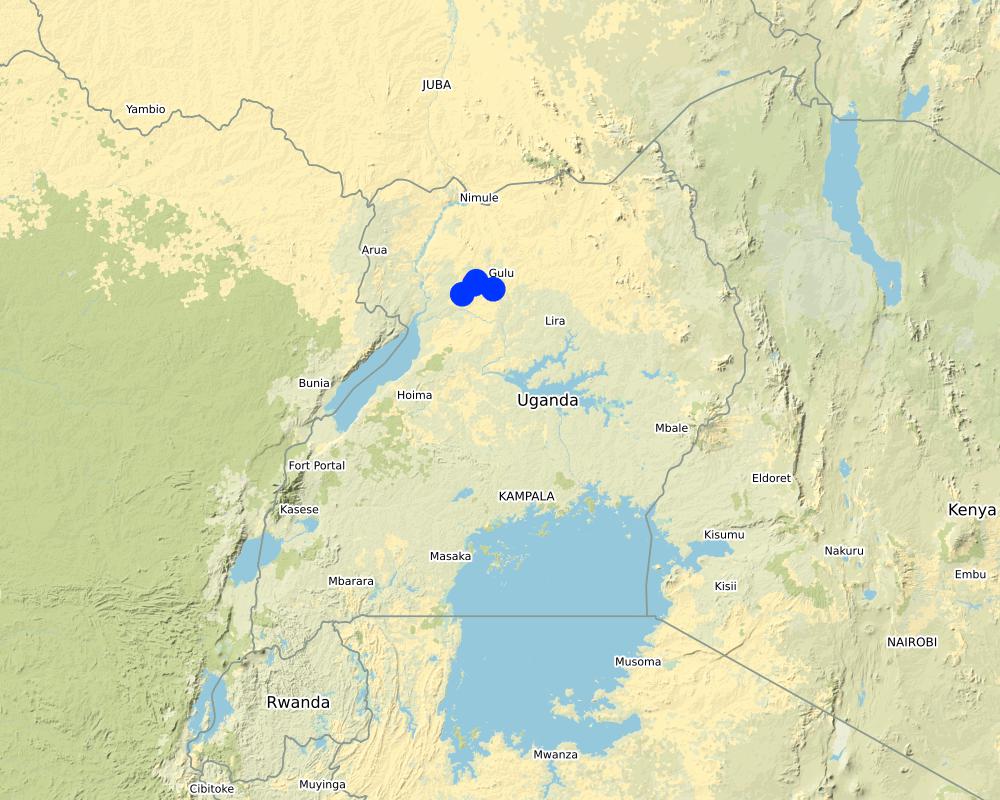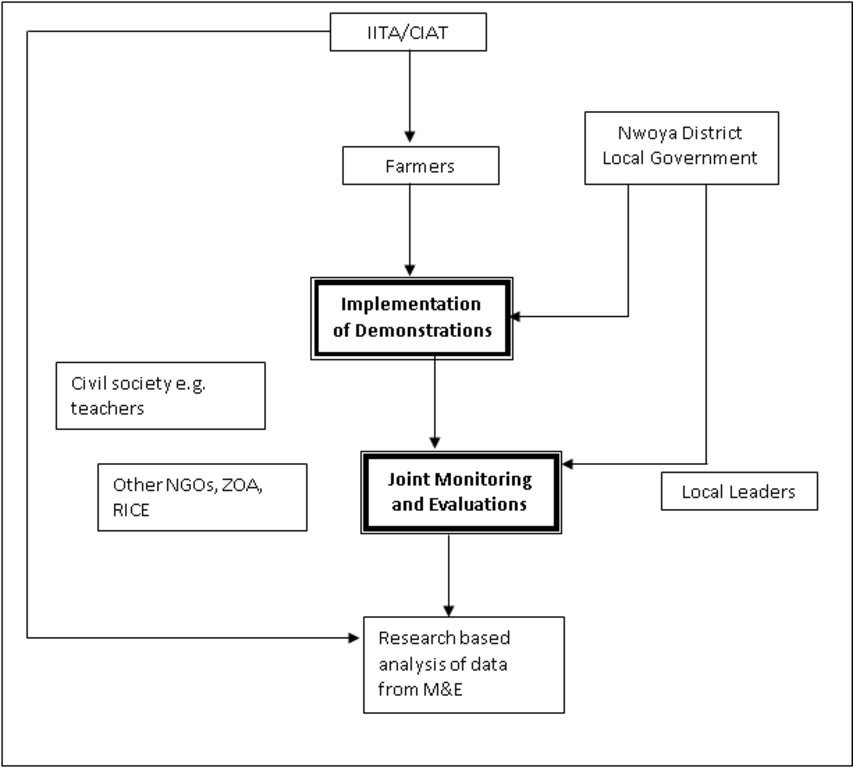Participatory Monitoring and Evaluation of Demonstration Plots [ยูกันดา]
- ผู้สร้างสรรค์:
- การอัพเดท:
- ผู้รวบรวม: Sunday Balla Amale
- ผู้เรียบเรียง: JOY TUKAHIRWA
- ผู้ตรวจสอบ: Udo Höggel
Lwak kamoko ber pa diro
approaches_3370 - ยูกันดา
ดูส่วนย่อย
ขยายทั้งหมด ย่อทั้งหมด1. ข้อมูลทั่วไป
1.2 รายละเอียดที่ติดต่อได้ของผู้รวบรวมและองค์กรที่เกี่ยวข้องในการประเมินและการจัดเตรียมทำเอกสารของแนวทาง
ชื่อของโครงการซึ่งอำนวยความสะดวกในการทำเอกสารหรือการประเมินแนวทาง (ถ้าเกี่ยวข้อง)
Scaling-up SLM practices by smallholder farmers (IFAD)ชื่อของโครงการซึ่งอำนวยความสะดวกในการทำเอกสารหรือการประเมินแนวทาง (ถ้าเกี่ยวข้อง)
Makerere University (Makerere University) - ยูกันดา1.3 เงื่อนไขที่เกี่ยวข้องกับการใช้ข้อมูลที่ได้บันทึกไว้ผ่านทาง WOCAT
วันที่เก็บรวบรวมข้อมูล (ภาคสนาม):
14/11/2017
ผู้รวบรวมและวิทยากรหลักยอมรับเงื่อนไขเกี่ยวกับการใช้ข้อมูลที่ถูกบันทึกผ่านทาง WOCAT:
ใช่
2. คำอธิบายของแนวทาง SLM
2.1 การอธิบายแบบสั้น ๆ ของแนวทาง
In Participatory Monitoring and Evaluation of demonstrations, all the players or stakeholders involved in the implementation of the demonstration come together to carry out a joint monitoring and evaluation of the performance of the technology being implemented.
2.2 การอธิบายอย่างละเอียดของแนวทาง
การอธิบายอย่างละเอียดของแนวทาง:
Demonstration plots established to train farmers are common channels through which recommended farming practice(s) are demonstrated to local farmers. During this process, all the relevant stakeholders in the agricultural sector, for example farmers, local leaders and government extension officers, partner organisations, and the lead implementing agency plan together on how best to implement the demonstration with emphasis on the host community, their roles and responsibilities so as to ensure successful implementation of the demonstration.
Stakeholders involved include:
•Group and community members (women, youth and men)
•Local leaders and authorities
•Civil servants
•Partner Non-Governmental Organisations (NGOs)
•Lead implementing agencies (International Institute of Tropical Agriculture, IITA and International Center for Tropical Agriculture, CIAT)
For the subsequent monitoring and evaluation (M&E) process, the participating stakeholders are invited for a field day on the site of the demonstration. Such M&E process is performed twice or three times during implementation of the demonstration activities depending on necessity, availability of time and resources. The M&E tool is designed by the M&E officer in the organization (IITA/CIAT) supported by the Field Officer/Research Assistant who is responsible for carrying out the field activities. The emphasis of the M&E process is on the goals and objectives, sustainability and adaptive nature, socio-economic and political environment, gender and policy considerations and impacts of the project being implemented. Group members help identifying the stakeholders in their community who can be resourceful in evaluating the demonstrations.
The Participatory Monitoring and Evaluation (PM&E) of the demonstration process, activities and performance is then carried out. It aims to:
•Assess the technology/practice(s) in question in terms of crop vigour and yield
•Understand the resilience of the practice to local prevailing climatic and weather conditions
•Assess whether equal opportunity was given for all community members to participate
•Assess the level of cooperation among group members during meetings
•Understand the gender perspectives with regard to gender equality, woman and youth involvement
•Test for the benefits, performance, pros and cons, and the opportunity cost involved in adopting a demonstrated technology
The PM&E questionnaire is based on IITA/CIAT PM&E tool and is composed of the following chapters:
1.Socio-demographic characteristics: district, sub-county, village, name, telephone contact, age, sex, educational level, employment and group-membership of the participant.
2.Farming characteristics: years of farming experience, total amount of land owned and allocated for farming or particular technology of interest, type of seed (local or improved) and the variety of the crop in question, source of seed and whether or not the participant participated in implementing the demonstration.
3.Implementation performance: Demo-plot location, distance, farmer trainings, demo-management, partnerships in the implementation, participation, cooperation, importance, relevance, monitoring of the demo, involvement in terms of community, gender, youth and the vulnerable groups and attendance.
4.Crop performance: Germination percentage, crop vigour, plant height, number of pods/cobs, pod/cob filling, maturity duration, yield, soil quality, pest occurrence, disease and drought resistance/tolerance.
5.Agro-ecological benefits: This can be ranked in terms of importance of the practice for soil fertility and bio-diversity, adaptation to weather variability and climate change.
6.Socio-economic benefits: This is ranked based on importance for household food and nutrition security, source of income, labour demands and cost of implementation.
7.Participants are then required to rank the technologies monitored.
The scale of ranking ranges from 1 to 5, where 1=Very Unhappy, 2=Unhappy, 3=neither Happy nor Unhappy, 4=Happy, 5=Very Happy. For certain questions, emoji illustrations are also used for the monitoring process.
2.3 รูปภาพของแนวทาง
2.5 ประเทศ ภูมิภาค หรือสถานที่ตั้งที่ได้นำแนวทางไปใช้
ประเทศ:
ยูกันดา
ภูมิภาค/รัฐ/จังหวัด: :
Northern Uganda
ข้อมูลเฉพาะเพิ่มเติมของสถานที่ตั้ง:
Nwoya District
Map
×2.6 วันที่เริ่มต้นและสิ้นสุดของแนวทาง
ถ้าไม่รู้ปีที่แน่นอนให้ประมาณวันที่ที่ริเริ่มใช้แนวทางนี้ :
น้อยกว่า 10 ปี (เร็วๆนี้)
2.7 ประเภทของแนวทาง
- ใช้โครงงานหรือแผนงานเป็นฐาน
2.8 เป้าหมายหรือวัตถุประสงค์หลักของแนวทาง
All stakeholders appreciate their involvement and hence adopt the technology for purposes of learning and knowledge sharing
2.9 เงื่อนไขที่เอื้ออำนวยหรือเป็นอุปสรรคต่อการนำเทคโนโลยีภายใต้แนวทางนี้ไปปฏิบัติใช้
บรรทัดฐานและค่านิยมทางสังคม วัฒนธรรม ศาสนา
- เอื้ออำนวย
Corperation among all stakeholders
- เป็นอุปสรรค
Time and resource needed to bring all stakeholders together
การมีไว้ให้หรือการเข้าถึงแหล่งการเงินและบริการ
- เอื้ออำนวย
This approach enables joint presentation and contribution of projects for funding
การจัดตั้งระดับองค์กร
- เอื้ออำนวย
Local farmer groups are activated , share knowledge and information
- เป็นอุปสรรค
Bureaucratic processes in decision making to participate in the process
การร่วมมือหรือการทำงานประสานกันของผู้ลงมือปฏิบัติ
- เอื้ออำนวย
Common interest in sustainable agriculture and support to farmer activities
กรอบแนวทางในการดำเนินการด้านกฎหมาย (การถือครองที่ดิน สิทธิในการใช้ที่ดินและน้ำ)
- เอื้ออำนวย
Presence of rules and regulations that bind the stakeholders to jointly monitor and evaluate as a team
- เป็นอุปสรรค
Poor and weak implementation and enforcement of rules and regulations
นโยบาย
- เอื้ออำนวย
Local and national policies on bottom up approach where all stakeholders are involved in decision making, starting from the lowest
การกำกับดูแลที่ดิน (การตัดสินใจ การนำเอาไปปฏิบัติใช้ และการบังคับใช้)
- เอื้ออำนวย
People are able to come together to participate in an activity that is related to land management
- เป็นอุปสรรค
Divergent interests and expectations during monitoring and evaluation
ความรู้เกี่ยวกับ SLM การเข้าถึงการสนับสนุนด้านเทคนิค
- เอื้ออำนวย
Learning about SLM from the process of monitoring and evaluation
ตลาด (จัดซื้อปัจจัยนำเข้า ขายผลิตภัณฑ์) และราคา
- เอื้ออำนวย
Affordable prices and quality inputs
- เป็นอุปสรรค
Exploitation by middle men and use of expired inputs on demonstration plots
ปริมาณงานที่ทำได้ กำลังคนที่มีให้
- เอื้ออำนวย
Shared roles and responsibilities among men and women during monitoring and evaluation
- เป็นอุปสรรค
Dominance resulting into conflicts over roles and responsibilities
อื่นๆ
- เอื้ออำนวย
Presence of monitoring and evaluation committee
- เป็นอุปสรรค
Understanding roles and responsibilities of the participatory monitoring and evaluation committee
3. การมีส่วนร่วมและบทบาทของผู้มีส่วนได้ส่วนเสียที่เกี่ยวข้อง
3.1 ผู้มีส่วนได้ส่วนเสียที่เกี่ยวข้องในแนวทางนี้และบทบาท
- ผู้ใช้ที่ดินระดับท้องถิ่นหรือชุมชนระดับท้องถิ่น
Farmers
Establish the demonstration, carry out activities in demonstrations, monitor and evaluate the demonstration
- องค์กรที่ขึ้นอยู่กับชุมชน
Local CBOs
Partipate in M&E of the demonstration
- นักวิจัย
International Institute of Tropical Agriculture (IITA), International Center for Tropical Agriculture (CIAT)
Introduced the monitoring / evaluation approach, participate in the monitoring process
- ครู เด็กนักเรียน หรือนักศึกษา
Teachers from local schools
Participate in monitoring / evaluation
- องค์กรพัฒนาเอกชน
Organisation ZOA - from relief to recovery (https://www.zoa-international.com/), other local NGOs
Participate in monitorng / evaluation
- รัฐบาลระดับท้องถิ่น
Subcounty and District officials
Participate in monitorng / evaluation
ถ้ามีผู้มีส่วนได้ส่วนเสียหลายคนที่เกี่ยวข้องให้ระบุหน่วยงานตัวแทน:
International Institute of Tropical Agriculture-IITA
3.2 การเกี่ยวข้องของผู้ใช้ที่ดินระดับท้องถิ่นหรือชุมชนระดับท้องถิ่นในช่วงต่างๆของแนวทาง
| ความเกี่ยวข้องของผู้ใช้ที่ดินระดับท้องถิ่นหรือชุมชนระดับท้องถิ่น | ระบุผู้ที่มีส่วนเกี่ยวข้องและอธิบายกิจกรรม | |
|---|---|---|
| การริเริ่มหรือการจูงใจ | ปฏิสัมพันธ์ | Farmers and local leaders |
| การวางแผน | จ่ายเงินหรือสนับสนุนจากภายนอก | Support from IITA |
| การดำเนินการ | ปฏิสัมพันธ์ | Farmers, Local leaders, Partner NGOs, IITA |
| การติดตามตรวจสอบหรือการประเมินผล | ปฏิสัมพันธ์ | Farmers, Local leaders, Partner NGOs, Policy makers |
| Publication of output | ไม่ลงมือ | IITA as the organisation implementing the project |
3.3 แผนผังแสดงขั้นตอนการทำงาน (ถ้ามี)
คำอธิบาย:
Flow chart showing process that leads to the implementation of participatory monitoring and evaluation
ผู้เขียน:
Sunday Balla
3.4 การตัดสินใจเลือกใช้เทคโนโลยี SLM
ระบุผู้ที่ทำการตัดสินใจเลือกเทคโนโลยีมากกว่าหนึ่งวิธีไปปฏิบัติใช้:
- ผู้ลงมือปฏิบัติที่เกี่ยวข้องทั้งหมดในฐานะที่เป็นส่วนรวมของแนวทาง
ระบุว่าการตัดสินใจตั้งอยู่บนพื้นฐานของ:
- การประเมินความรู้ SLM ที่ได้ทำการบันทึกไว้เป็นอย่างดี (การใช้ข้อมูลในการตัดสินใจ)
4. การสนับสนุนด้านเทคนิค การสร้างขีดความสามารถ และการจัดการด้านความรู้
4.1 การสร้างขีดความสามารถ / การอบรม
ได้มีการจัดอบรมให้แก่ผู้ใช้ที่ดินหรือผู้มีส่วนได้ส่วนเสียคนอื่น ๆ หรือไม่:
ใช่
ให้ระบุว่าใครเป็นผู้ได้รับการอบรม:
- ผู้ใช้ที่ดิน
- เจ้าหน้าที่ภาคสนาม / ที่ปรึกษา
รูปแบบการอบรม:
- ใช้พื้นที่ทำการสาธิต
4.2 การบริการให้คำแนะนำ
ผู้ใช้ที่ดินมีการเข้าถึงการรับบริการให้คำปรึกษาหรือไม่:
ใช่
- Demonstration sites identified by farmers
4.3 การเสริมความแข็งแกร่งให้กับสถาบัน (การพัฒนาองค์กร)
สถาบันได้รับการจัดตั้งขึ้นมาหรือเสริมความแข็งแกร่งโดยแนวทางนี้หรือไม่:
- ใช่ ปานกลาง
ระบุระดับของสถาบันที่ได้รับการเสริมความแข็งแกร่งหรือจัดตั้งขึ้นมา:
- ท้องถิ่น
- ภูมิภาค
- ประเทศ
ระบุประเภทของการให้ความช่วยเหลือสนับสนุน:
- การสร้างขีดความสามารถ / การอบรม
4.4 การติดตามตรวจสอบและประเมินผล
การติดตามตรวจสอบและประเมินผลเป็นส่วนหนึ่งของแนวทางหรือไม่:
ใช่
ความคิดเห็น:
It is the exact approach
ถ้าตอบว่าใช่ แสดงว่าการจัดเตรียมเอกสารนี้มุ่งหวังที่จะเอาไปใช้สำหรับการติดตามตรวจสอบและประเมินผลใช่หรือไม่:
ใช่
4.5 การวิจัย
การวิจัยเป็นส่วนหนึ่งของแนวทางหรือไม่:
ใช่
ระบุหัวข้อเรื่อง:
- นิเวศวิทยา
ให้ข้อมูลเพิ่มเติมและให้ระบุผู้ทำการวิจัย:
IITA-Climate Smart Agriculture Research. Research focused on increasing food security and farming systems' resilience in East Africa
5. การสนับสนุนด้านการเงินและวัสดุอุปกรณ์
5.1 ระบุงบประมาณประจำปีสำหรับแนวทาง SLM นี้
ถ้าหากว่างบประมาณประจำปีไม่เป็นที่ทราบแน่นอน ให้ระบุช่วงลงไป:
- 2,000-10,000
5.2 การสนับสนุนด้านการเงิน / วัสดุอุปกรณ์ให้แก่ผู้ใช้ที่ดิน
ผู้ใช้ที่ดินได้รับการสนับสนุนด้านการเงิน / วัสดุอุปกรณ์ไปปฏิบัติใช้เทคโนโลยีหรือไม่:
ไม่ใช่
5.3 เงินสนับสนุนสำหรับปัจจัยนำเข้า (รวมถึงแรงงาน)
- ไม่มี
ถ้าแรงงานโดยผู้ใช้ที่ดินเป็นปัจจัยนำเข้าที่มีอยู่มากมาย ระบุด้วยว่าเนื่องจาก:
- สมัครใจ
5.4 เครดิต
มีการจัดหาเครดิตมาให้ภายใต้แนวทาง SLM หรือไม่:
ไม่ใช่
5.5 แรงจูงใจหรือเครื่องมืออื่น ๆ
แรงจูงใจหรือเครื่องมืออื่น ๆ ได้ถูกนำไปใช้ส่งเสริมการใช้เทคโนโลยี SLM หรือไม่:
ใช่
ถ้าใช่ ระบุ:
Refreshments during PM&E and demonstration activities eg. water or soft drinks
6. การวิเคราะห์ผลกระทบและการสรุป
6.1 ผลกระทบของแนวทาง
ทำให้ผู้ใช้ที่ดินระดับท้องถิ่นมีอำนาจขึ้น ปรับปรุงการเข้าร่วมของผู้มีส่วนได้ส่วนเสียให้ดีขึ้นหรือไม่:
- ไม่ใช่
- ใช่ เล็กน้อย
- ใช่ ปานกลาง
- ใช่ อย่างมาก
Local users understand what kind of paramenters can be considered for an evaluation
ช่วยในการตัดสินใจโดยดูจากหลักฐาน ได้หรือไม่:
- ไม่ใช่
- ใช่ เล็กน้อย
- ใช่ ปานกลาง
- ใช่ อย่างมาก
The approach enables farmers to take decisions based on what they observed during the evaluation process
ปรับปรุงความร่วมมือกันและการดำเนิน งานของ SLM ได้อย่างมีประสิทธิผลหรือไม่:
- ไม่ใช่
- ใช่ เล็กน้อย
- ใช่ ปานกลาง
- ใช่ อย่างมาก
All stakeholders took part in the implementation and PM&E process. This improved coordination and resource sharing
ระดมกำลังหรือปรับปรุงการเข้าถึงแหล่ง เงินทุนสำหรับการดำเนินการ SLM หรือไม่:
- ไม่ใช่
- ใช่ เล็กน้อย
- ใช่ ปานกลาง
- ใช่ อย่างมาก
Stakeholder platform helps to share and identify potential sources of resource and fund mobilisation
ปรับปรุงความรู้และความสามารถของผู้ใช้ที่ดินในการดำเนินการ SLM หรือไม่:
- ไม่ใช่
- ใช่ เล็กน้อย
- ใช่ ปานกลาง
- ใช่ อย่างมาก
Each participant understood in depth the process involved in implementing a given technology
ปรับปรุงความรู้และความสามารถของผู้มีส่วนได้ส่วนเสียคนอื่น ๆ ให้ดีขึ้นหรือไม่:
- ไม่ใช่
- ใช่ เล็กน้อย
- ใช่ ปานกลาง
- ใช่ อย่างมาก
Participants learned important indicators for demonstrations and how to assess them
ทำให้ผู้ใช้ที่ดินระดับท้องถิ่นมีอำนาจขึ้น ปรับปรุงการเข้าร่วมของผู้มีส่วนได้ส่วนเสียให้ดีขึ้นหรือไม่:
- ไม่ใช่
- ใช่ เล็กน้อย
- ใช่ ปานกลาง
- ใช่ อย่างมาก
Many stakeholders were part of the platform, ranging from local schools and institutions as part of the civil society
ช่วยบรรเทาความขัดแย้งหรือไม่:
- ไม่ใช่
- ใช่ เล็กน้อย
- ใช่ ปานกลาง
- ใช่ อย่างมาก
Participants learned how to collaborate in groups
ทำให้กลุ่มด้อยโอกาสมีอำนาจทางสังคมและเศรษฐกิจหรือไม่:
- ไม่ใช่
- ใช่ เล็กน้อย
- ใช่ ปานกลาง
- ใช่ อย่างมาก
All community members were invited to learn and participate hence acquiring knowledge
ปรับปรุงความทัดเทียมกันด้านเพศและให้อำนาจแก่ผู้หญิงและเด็กผู้หญิงหรือไม่:
- ไม่ใช่
- ใช่ เล็กน้อย
- ใช่ ปานกลาง
- ใช่ อย่างมาก
The approach involved all age groups and gender with focus on widows
ส่งเสริมให้เยาวชนหรือบุตรหลานของผู้ใช้ที่ดินให้เข้าร่วมใน SLM:
- ไม่ใช่
- ใช่ เล็กน้อย
- ใช่ ปานกลาง
- ใช่ อย่างมาก
Youth were at the forefront of implementation
ปรับปรุงประเด็นของการถือครองที่ดินหรือสิทธิในการใช้ ซึ่งขัดขวางการนำเทคโนโลยีไปใช้ให้ดีขึ้น:
- ไม่ใช่
- ใช่ เล็กน้อย
- ใช่ ปานกลาง
- ใช่ อย่างมาก
Participants learned about the importance of learning and the allocation for various activities. ZOA carried out land and conflict resolutions and helped farmers acquiring land titles from the Government
นำไปสู่ความมั่นคงด้านอาหารหรือปรับปรุงโภชนาการให้ดีขึ้น:
- ไม่ใช่
- ใช่ เล็กน้อย
- ใช่ ปานกลาง
- ใช่ อย่างมาก
Participants identify which technology addresses their food and nutrition security needs
ปรับปรุงการเข้าถึงตลาดหรือไม่:
- ไม่ใช่
- ใช่ เล็กน้อย
- ใช่ ปานกลาง
- ใช่ อย่างมาก
Farmers identify which technology is a suitable income basing on the available market opportunities
นำไปสู่การเข้าถึงเรื่องน้ำและสุขาภิบาลได้ดีขึ้นหรือไม่:
- ไม่ใช่
- ใช่ เล็กน้อย
- ใช่ ปานกลาง
- ใช่ อย่างมาก
The approach utilized local community group which also carry out Savings, borehole maintenance and community Village Health teams
ปรับปรุงความสามารถของผู้ใช้ที่ดินในการปรับตัวให้เข้ากับการเปลี่ยนแปลงของสภาพภูมิอากาศหรือสภาพที่รุนแรงและภัยพิบัติหรือไม่:
- ไม่ใช่
- ใช่ เล็กน้อย
- ใช่ ปานกลาง
- ใช่ อย่างมาก
Farmers identify technologies, resilient to weather variability and weather extremes
6.2 แรงจูงใจหลักของผู้ใช้ที่ดินเพื่อที่จะนำ SLM ไปปฏิบัติใช้
- การผลิตที่เพิ่มขึ้น
High yields of crops
- กำไร (ความสามารถ) อัตราส่วนค่าใช้จ่ายต่อผลประโยชน์ที่เพิ่มขึ้น
Market available for the products from SLM technology
- การเสื่อมของที่ดินลดลง
Soil and fertility management
- ความเสี่ยงของภัยพิบัติลดลง
Reduced risks of drought, pest and disease incidences, floods
6.3 ความยั่งยืนของกิจกรรมของแนวทาง
ผู้ใช้ที่ดินสามารถทำให้สิ่งต่างๆ ที่ได้ปฏิบัติใช้โดยแนวทางนี้ยั่งยืนได้หรือไม่ (โดยไม่มีการสนับสนุนจากภายนอก):
- ใช่
ถ้าตอบว่าใช่ ให้อธิบายว่าอย่างไร :
During the PM&E Process, the land users are required to indicate their interest in the adoption of particular technologies and the challenges they would face. Therefore this process enables the farmers to know the requirements for implementing a given technology, pros and cons and how to sustain it economically and environmentally.
6.4 จุดแข็งและข้อได้เปรียบของแนวทาง
| จุดแข็ง / ข้อได้เปรียบของแนวทางในทัศนคติของผู้ใช้ที่ดิน |
|---|
| It is participatory |
| All stakeholders are involved |
| Individual opinions is considered |
| จุดแข็ง / ข้อได้เปรียบของแนวทางในทัศนคติของผู้รวบรวมหรือวิทยากรหลัก |
|---|
| It is a research based approach and quantitative data can be obtained from such an approach |
| Basic sign and labels on the PM&E tool is easy for local farmers to understand |
6.5 จุดอ่อน / ข้อเสียเปรียบของแนวทางและวิธีในการแก้ไข
| จุดอ่อน / ข้อเสียเปรียบในทัศนคติของผู้ใช้ที่ดิน | สามารถแก้ไขปัญหาได้อย่างไร |
|---|---|
| The participants may not understand clearly what information is required of them. This can be due to misunderstanding of questions, indicators and possible responses if they are not properly explained. | Eloquent speaker of the local language should act as enumerator to clearly explain what is required of the participants. This can be coupled with emoji illustrations besides the questionnaire. |
| จุดอ่อน / ข้อเสียเปรียบในทัศนคติของผู้รวบรวมหรือวิทยากรหลัก | สามารถแก้ไขปัญหาได้อย่างไร |
|---|---|
| Simple, visible and easy to understand attributes or parameters are considered. for example plant yield, vigor, participation. Some factors like long term benefits, cost benefit considerations were not included. | Perceptions and Attitudes, Simple cost benefit considerations can be included in the evaluation. |
7. การอ้างอิงและการเชื่อมต่อ
7.1 วิธีการหรือแหล่งข้อมูล
- ไปเยี่ยมชมภาคสนาม การสำรวจพื้นที่ภาคสนาม
All stakeholders involved during the field day activity should participate in the PM&E
ลิงก์และโมดูล
ขยายทั้งหมด ย่อทั้งหมดลิงก์
ไม่มีลิงก์
โมดูล
ไม่มีโมดูล


